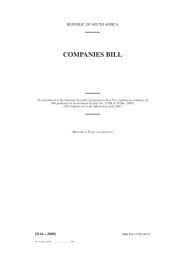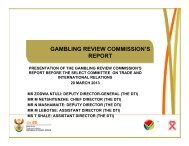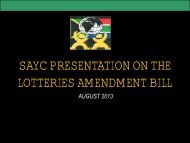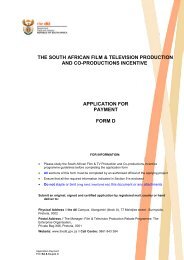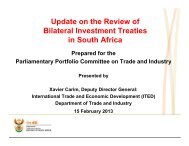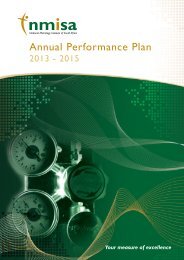Copyright Review Commission Report - ICT Law and Regulation ...
Copyright Review Commission Report - ICT Law and Regulation ...
Copyright Review Commission Report - ICT Law and Regulation ...
- No tags were found...
Create successful ePaper yourself
Turn your PDF publications into a flip-book with our unique Google optimized e-Paper software.
14.1.5. The total music royalty collections as a percentage of the GDP (in Table 28 (a)) amounted to 0,0128% in 2010 forSouth Africa <strong>and</strong> is the third-lowest ratio among the countries selected for benchmarking. France <strong>and</strong> the UK havethe highest ratios at 0,0468% <strong>and</strong> 0,0417% respectively. The higher ratios for the developed countries (mainlyFrance <strong>and</strong> the UK) are largely because: Higher tariffs are in place; Major problems around the royalty collections of the digital downloads <strong>and</strong> ringtones have been resolved; There is a lower proportion of unlicensed users; <strong>and</strong> Turnaround times for tariff disputes are shorter, <strong>and</strong> the industry is more mature.Brazil’s ratio is the second lowest among the selected countries, largely because of lower tariffs. Only 50% of theradio broadcasters pay for the usage of music <strong>and</strong> a significant number of commercial music users are notrequired to take licences.14.1.6. A higher growth rate in collections (of 16%) in Brazil (in Table 28 (b)) is largely because of the low base (growth inthe market <strong>and</strong> awareness of the users about the need to get the appropriate licences). An 11% growth for SouthAfrica is mainly due to the growth phase of SAMPRA.14.1.7. Despite the fact that collections are not generated for needletime rights from local broadcasters, South Africa’sratio of broadcasting collections to total collections st<strong>and</strong>s at 48% (in Table 28 (c)), which is the third-highestamong the selected countries. This is a clear indication of the fact that the collection problems are not limited tobroadcasting. As indicated above, there are other problems with local collections.14.1.8. The average collections per employee (in Table 28 (d)) for Brazil of R2 132 632 (for 2010) is based on theemployees numbers for ECAD (Central Collection <strong>and</strong> Distribution Agency) <strong>and</strong> does not include the employeesnumbers for the 10 collecting societies. The average for SAMRO is R1 620 806 (which is second-lowest amongthe parties selected for benchmarking). The unfavourable ratio for SAMRO is due to: Some of the human resources are assigned to the management of the investment portfolios, Tariffs are relatively lower, <strong>and</strong> The staff numbers are relatively higher.SAMPRA’s average is R4 116 111 per employee. This was achieved without the broadcasting <strong>and</strong> some retailcollections <strong>and</strong>, therefore, SAMPRA’s ratio can be expected to improve once the disputes are resolved.14.1.9. In computing the average distributions per member (in Table 28 (e)), the foreign distributions have been excludedsince they are not payable to members but rather to sister societies.14.1.10. The average pay per employee per annum for IPRS amounted to R39 447 (in Table 28 (f)) compared to SAMRO<strong>and</strong> SAMPRA at R298 893 <strong>and</strong> R494 423 respectively. The annual pay for IPRS is almost equal to the monthlyaverage pay for SAMPRA.14.1.11. With regard to collections (licence revenues) generated for every r<strong>and</strong> spent on labour cost (in Table 28 (g)),SAMRO has the lowest ratio of R5,42. This is in line with the ratio of administration cost-to-royalty revenue of- 99 -





